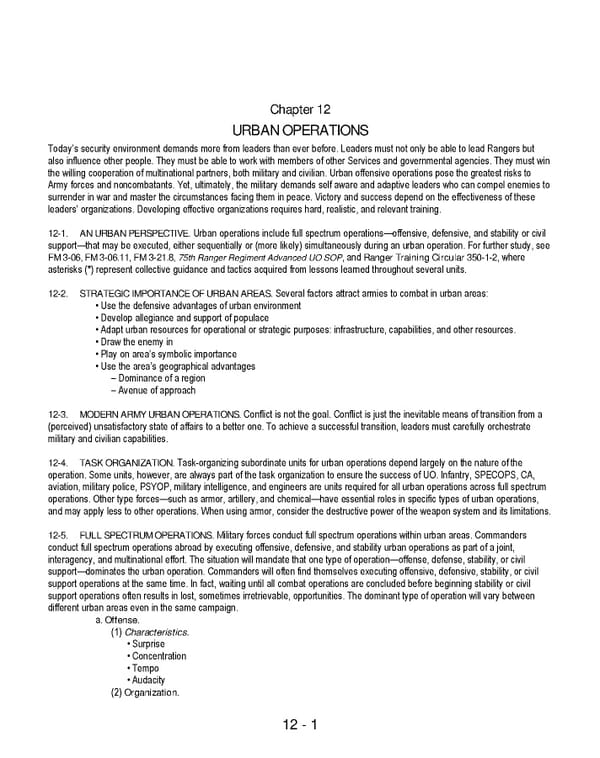12 - 1 Chapter 12 URBAN OPERATIONS Today’s security environment demands more from leaders than ever before. Leaders must not only be able to lead Rangers but also influence other people. They must be able to work with members of other Services and governmental agencies. They must win the willing cooperation of multinational partners, both military and civilian. Urban offensive operations pose the greatest risks to Army forces and noncombatants. Yet, ultimately, the military demands self aware and adaptive leaders who can compel enemies to surrender in war and master the circumstances facing them in peace. Victory and success depend on the effectiveness of these leaders’ organizations. Developing effective organizations requires hard, realistic, and relevant training. 12-1. AN URBAN PERSPECTIVE. Urban operations include full spectrum operations—offensive, defensive, and stability or civil support—that may be executed, either sequentially or (more likely) simultaneously during an urban operation. For further study, see FM 3-06, FM 3-06.11, FM 3-21.8, 75th Ranger Regiment Advanced UO SOP, and Ranger Training Circular 350-1-2, where asterisks (*) represent collective guidance and tactics acquired from lessons learned throughout several units. 12-2. STRATEGIC IMPORTANCE OF URBAN AREAS. Several factors attract armies to combat in urban areas: • Use the defensive advantages of urban environment • Develop allegiance and support of populace • Adapt urban resources for operational or strategic purposes: infrastructure, capabilities, and other resources. • Draw the enemy in • Play on area’s symbolic importance • Use the area’s geographical advantages – Dominance of a region – Avenue of approach 12-3. MODERN ARMY URBAN OPERATIONS. Conflict is not the goal. Conflict is just the inevitable means of transition from a (perceived) unsatisfactory state of affairs to a better one. To achieve a successful transition, leaders must carefully orchestrate military and civilian capabilities. 12-4. TASK ORGANIZATION. Task-organizing subordinate units for urban operations depend largely on the nature of the operation. Some units, however, are always part of the task organization to ensure the success of UO. Infantry, SPECOPS, CA, aviation, military police, PSYOP, military intelligence, and engineers are units required for all urban operations across full spectrum operations. Other type forces—such as armor, artillery, and chemical—have essential roles in specific types of urban operations, and may apply less to other operations. When using armor, consider the destructive power of the weapon system and its limitations. 12-5. FULL SPECTRUM OPERATIONS. Military forces conduct full spectrum operations within urban areas. Commanders conduct full spectrum operations abroad by executing offensive, defensive, and stability urban operations as part of a joint, interagency, and multinational effort. The situation will mandate that one type of operation—offense, defense, stability, or civil support—dominates the urban operation. Commanders will often find themselves executing offensive, defensive, stability, or civil support operations at the same time. In fact, waiting until all combat operations are concluded before beginning stability or civil support operations often results in lost, sometimes irretrievable, opportunities. The dominant type of operation will vary between different urban areas even in the same campaign. a. Offense. (1) Characteristics. • Surprise • Concentration • Tempo • Audacity (2) Organization.
 Ranger Handbook Page 224 Page 226
Ranger Handbook Page 224 Page 226